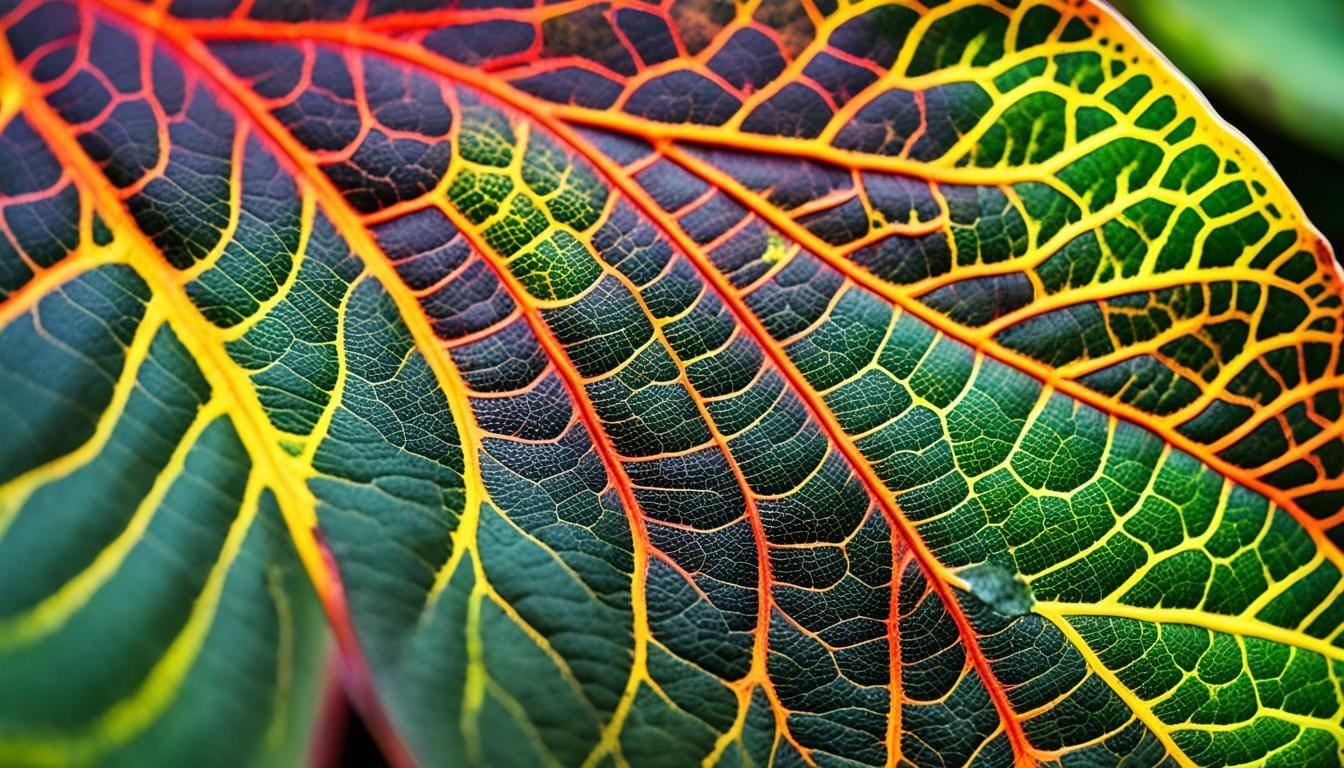Did you know the Croton plant is super pretty? It can make any room look bright. It has many kinds, each with cool leaf colors and patterns. You’ll see reds, oranges, yellows, and greens.
If you want to make your place colorful, choose Croton plants. I’ll teach you all about growing them. You’ll learn about light, water, potting, and how to make more Crotons. Let’s make your Croton plant awesome!
Key Takeaways:
- Choose from a variety of Croton plant varieties with unique leaf colors and patterns.
- Proper light, water, and potting practices are essential for the health and growth of Croton plants.
- Croton plants require bright, indirect light and prefer moist but not overly saturated soil.
- Fertilize the plant regularly during the growing season to promote healthy growth and vibrant foliage.
- Regularly monitor the plant for pests and diseases and take appropriate measures for control.
Why Do We Love the Croton Plant For Apartments?
People living in apartments love the Croton plant. It makes indoor spaces colorful and lively. Its many colors bring nature inside, making homes welcoming and pretty.
Is the Croton Plant Air-Purifying?
The Croton plant also cleans the air. It removes bad stuff like formaldehyde and benzene. This makes indoor air healthier for you and your family.
Is the Croton Plant Pet-Friendly?
But, the Croton plant is not safe for pets. Its leaves have toxins that can hurt pets. If you have pets, pick plants that are safe for them.
How Big Does the Croton Plant Get?
Croton plants can be 2 to 3 feet tall. But some can grow to 6 feet with good care. Pick a Croton that fits your space without taking over.
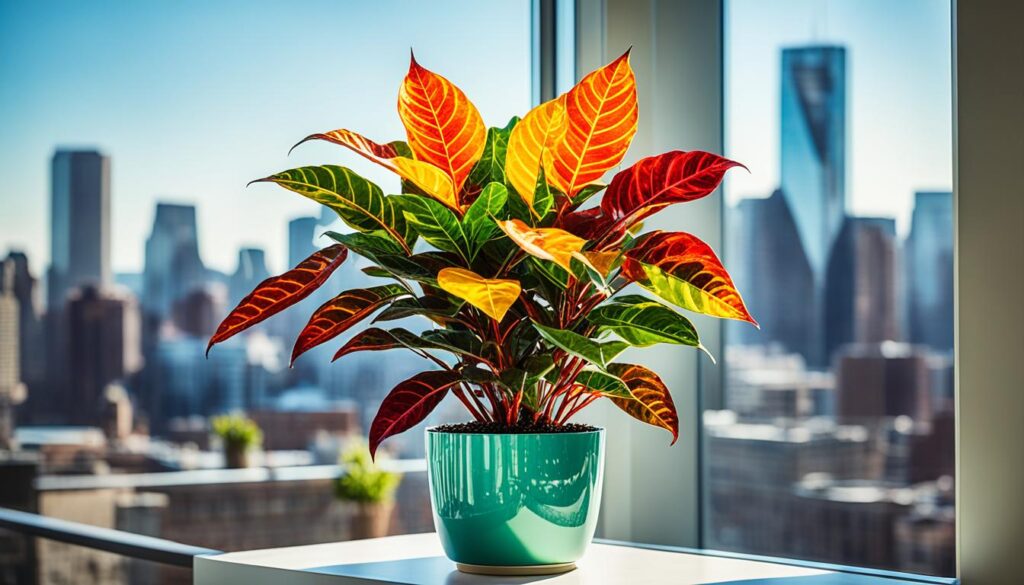
The Croton plant is great for adding nature to apartments. But remember, it’s not safe for pets. It’s perfect for making your space lively and clean. Choose pet-safe plants if you have pets. The Croton is great for plant lovers or if you’re just starting.
How to Grow a Croton Plant – Learn to Grow this Indoor Beauty
To grow a Croton plant well, pay attention to key things. Right potting, light, water, fertilizer, pruning, and care are vital. Your Croton will then be healthy and beautiful.
Choosing the Right Pot and Soil
Choose a pot that drains water well for your Croton. This stops root rot. Pick a pot a bit bigger than the plant’s roots.
The soil should drain well and include soil, perlite, and orchid bark. This mix gives roots what they need.
Providing Adequate Light
Croton plants need bright, indirect light. Put your plant near a window but out of direct sun. Direct sun can harm its leaves.
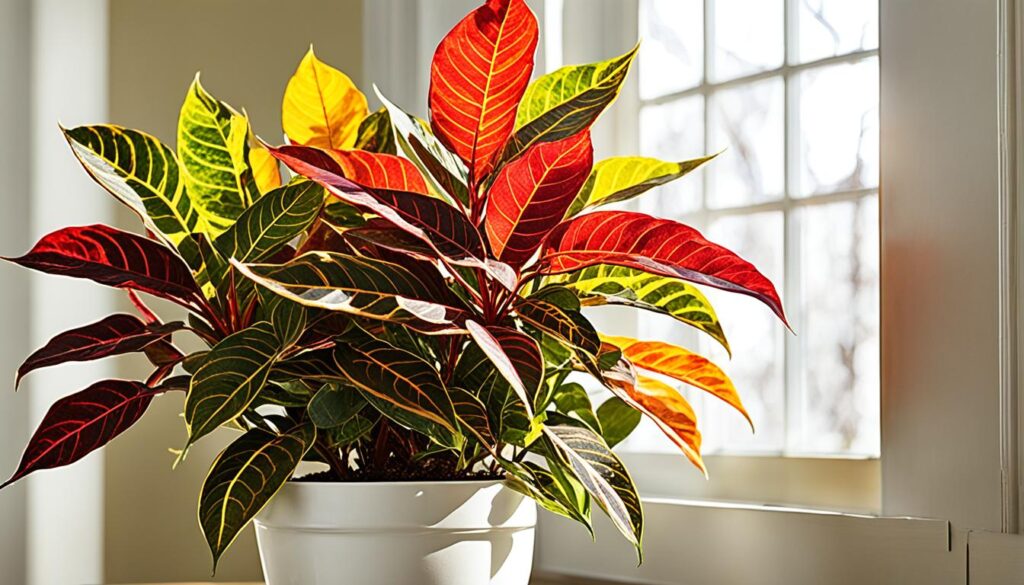
Watering and Humidity
Water is key for Crotons. Keep soil moist but don’t overdo it to avoid rot. Check the soil’s top inch before watering. If dry, water it well.
Crotons love humid air. So, mist their leaves or use a humidifier to help them.
Nutrition and Fertilization
Fertilize your plant in spring and summer every 4-6 weeks. Use a balanced liquid fertilizer. Follow what the label says.
Pruning and Maintenance
Pruning keeps your Croton looking good. Remove any leaves that are dead or yellow to keep it healthy.
Propagation
You can grow new Crotons from stem cuttings or by dividing a plant. For cuttings, put a stem piece in water or soil until roots grow. Then plant it. When dividing, make sure each piece has roots.
Monitoring for Pests and Diseases
Watch for pests like spider mites and mealybugs. Use natural or chemical ways to get rid of them. Also, look out for diseases and fix them fast.
If you take care of your Croton plant this way, you’ll enjoy its beauty for many years.
Appearance of Croton Plant
The Croton plant brightens up any indoor area. Its large, leathery leaves come in many colors.
These colors include green, yellow, orange, red, and purple. This adds a splash of color. The leaves might also have different patterns, making the plant stand out.
Leaves can be oval or long. They might have cool patterns or veins. This makes the plant even more interesting. You can find Crotons in lots of different styles.
The Croton plant has big, colorful leaves. It makes any room look better. Its beauty adds life and color to indoor spaces.
Light Requirements for Croton Plant
The Croton plant loves bright, indirect light. Place it near a window for best results. But keep it away from direct sun. That can harm its leaves.
Are the leaves losing their bright colors? It might need more light. Move your plant to a brighter spot. This will help it stay healthy and colorful.

Watering Requirements of the Croton Plant
Watering your Croton plant right is super important. This plant needs soil that is moist but not too wet. Finding the perfect balance stops too much or too little water, which is bad for the plant.
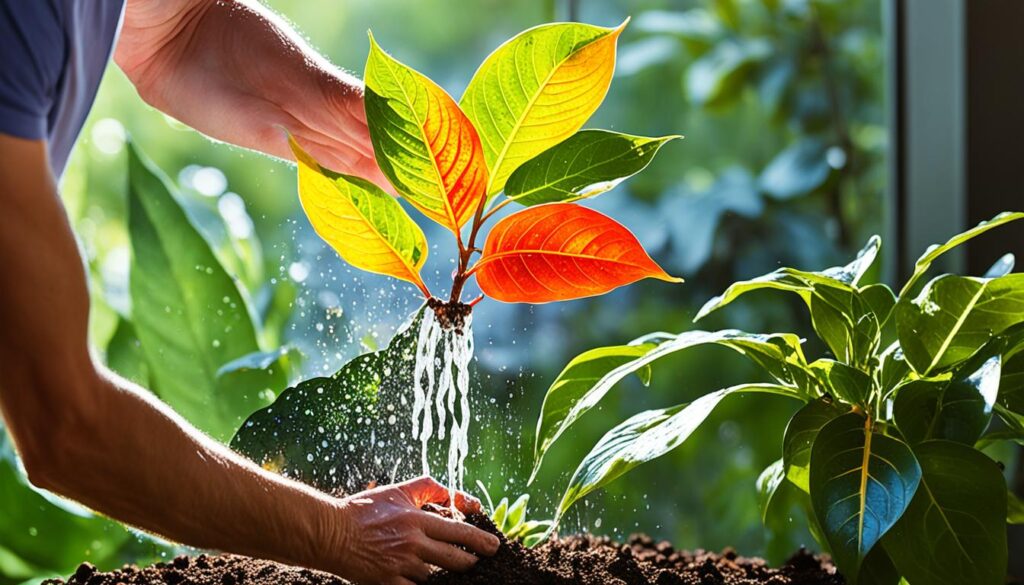
Yellow leaves, wilting, and root rot mean too much water. If you see this, change how much you water. Drooping leaves and dry soil mean not enough water. This stress stops the plant from growing well.
Check the soil’s moisture to water your Croton right. Put your finger an inch in the soil. If it’s dry, water the plant. It’s important to keep the soil evenly moist but not soggy.
Water needs can change with the weather. You might water more when it’s hot and dry. Water less when it’s cool and humid. Watch your plant and change your watering as needed.
Knowing how to water your Croton helps it stay healthy. Paying attention to water signs means your plant will do well.
Fertilizing a Croton Plant
Fertilizing is key for a Croton plant’s health and bright leaves. It needs the right food to look good and grow. This care helps it make energy and stay healthy.
Feed it with liquid food every 4-6 weeks in spring and summer. This helps it grow well during its main growing time.
Choose a fertilizer made for indoor plants. Make sure it has what Crotons need. Always follow the instructions to avoid harming the plant.
Put the fertilizer around the plant’s base but not on the leaves. This stops the leaves from getting burnt.
Less food is needed when it’s not growing much, in fall and winter. So, fertilize it less often then to avoid too much nutrient buildup.
Recommended Fertilizer for a Croton Plant
Look for a fertilizer with a mix of big and small nutrients. A 10-10-10 or 20-20-20 mix is usually good for Crotons.
Croton plant fertilization likes a lot of nitrogen for its leaves and colors. Nitrogen helps make the green color. A balanced fertilizer gives it what it needs.
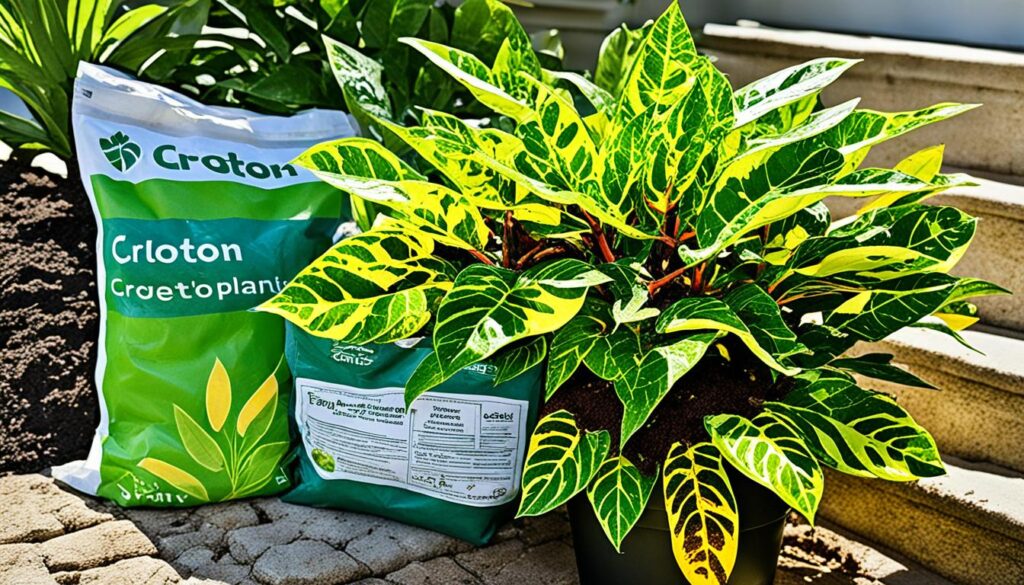
| Fertilizer Name | NPK Ratio | Key Features |
|---|---|---|
| Example Fertilizer 1 | 10-10-10 | Provides balanced nutrition for healthy growth and foliage |
| Example Fertilizer 2 | 20-20-20 | Offers higher nutrient concentration for enhanced growth and vibrant colors |
| Example Fertilizer 3 | 12-6-6 | Rich in nitrogen for vigorous leaf development |
Follow the label when mixing the fertilizer. Too much can harm the plant. It’s better to use less than too much.
With the right food, water, light, and care, your Croton will thrive. Keep a regular food schedule to enjoy beautiful leaves and a happy plant.
Potting a Croton Plant
Potting a Croton plant right helps it grow well. Choose the right pot and mix. Know when to repot.
Choosing the Right Pot Size
Choose a pot that drains well and is just bigger than the root. This lets roots grow without getting too tight. A too-big pot may cause root rot from too much water.
Using the Right Potting Mix for a Croton Plant
The potting mix is key for a Croton’s health. Use a mix that drains well. It should include soil, perlite, and orchid bark. This keeps soil from waterlogging and lets roots breathe. Avoid dense soils.
Repotting When Necessary
Repot a Croton every 1-2 years to give it space. Do it in spring or when roots get crowded. Move the plant gently to a new pot. Make sure the root top is even with the pot’s top. Add new mix and press it down softly.
Be gentle with the roots to avoid harm. Crotons don’t like their roots being messed with too much.
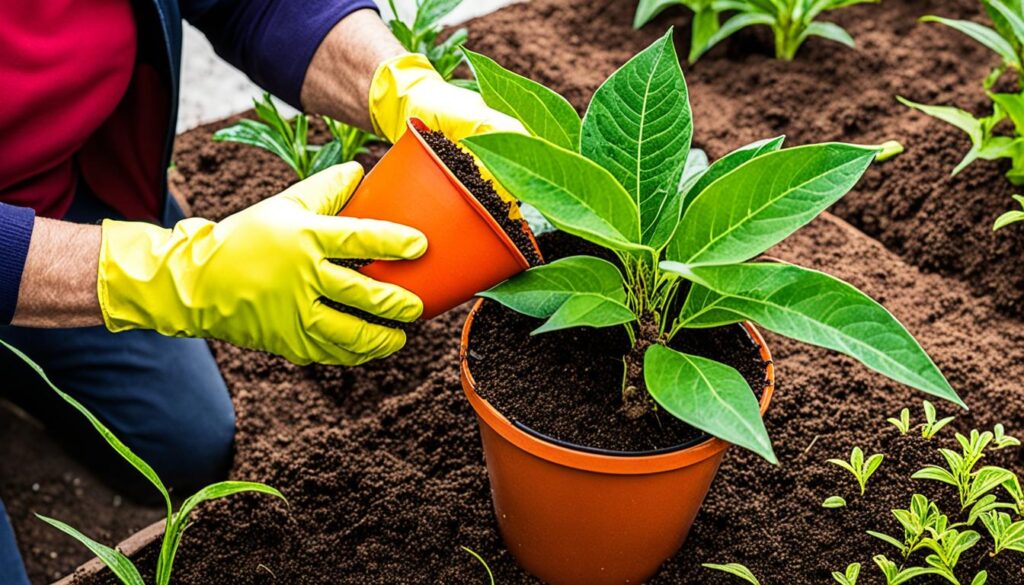
Propagating a Croton Plant
There are two ways to make more Croton plants: stem cuttings and division. You can pick the way you like best, depending on what you have.
Stem Cuttings or Seeds?
To grow a Croton from a stem, find a healthy stem first. Cut it just below where a leaf comes out. Put the cutting in water or something that helps roots grow. When it has roots, plant it in good soil.
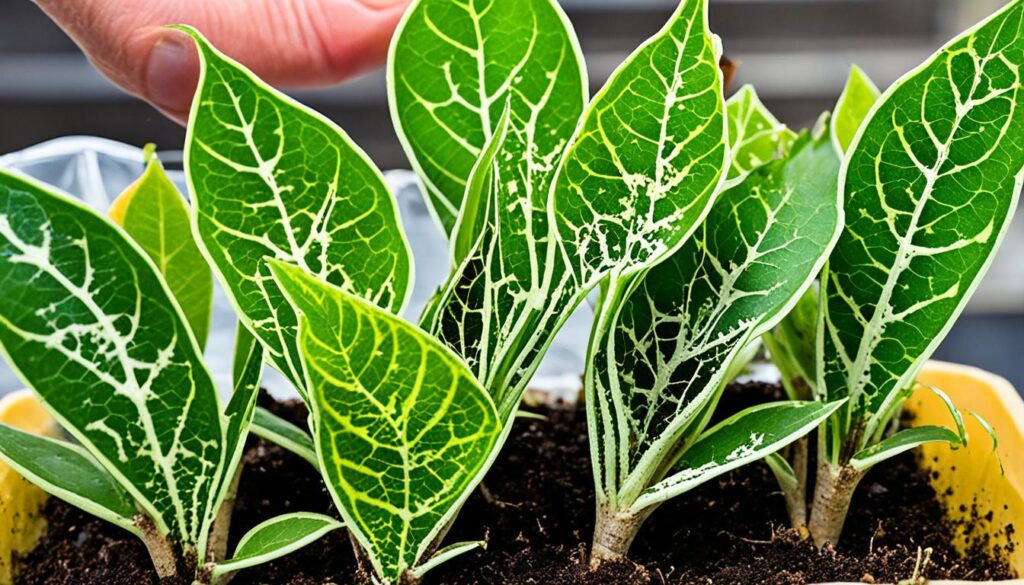
Division is another way to get more plants. It means making parts from a big Croton plant. Each part must have some roots. Carefully split the root ball or pull apart stem groups. Make sure every part has enough roots.
Division of a Croton Plant
If your Croton plant is big and bushy, division is great. It helps you make new plants. You can put each new plant in its pot. This way, your Croton plants will have space to grow well.
Growth and Development of the Croton Plant
The Croton plant grows slowly but can get 2 to 3 feet tall in the best conditions. Its growth relies on light, water, temperature, and food.
For good growth, give your Croton plenty of light. It should be in bright, indirect light. This helps it make food and grow new leaves.
Watering right is key too. The soil should stay moist but not too wet. Too much water can harm the roots. Check the soil and water as needed.
Temperature matters for the Croton plant. Keep it in a warm place, between 60°F to 80°F. Cold or chilly air can slow its growth.
Nutrition helps the plant develop well. Use a balanced liquid fertilizer often when it grows. This gives it the nutrients for strong growth and bright leaves.
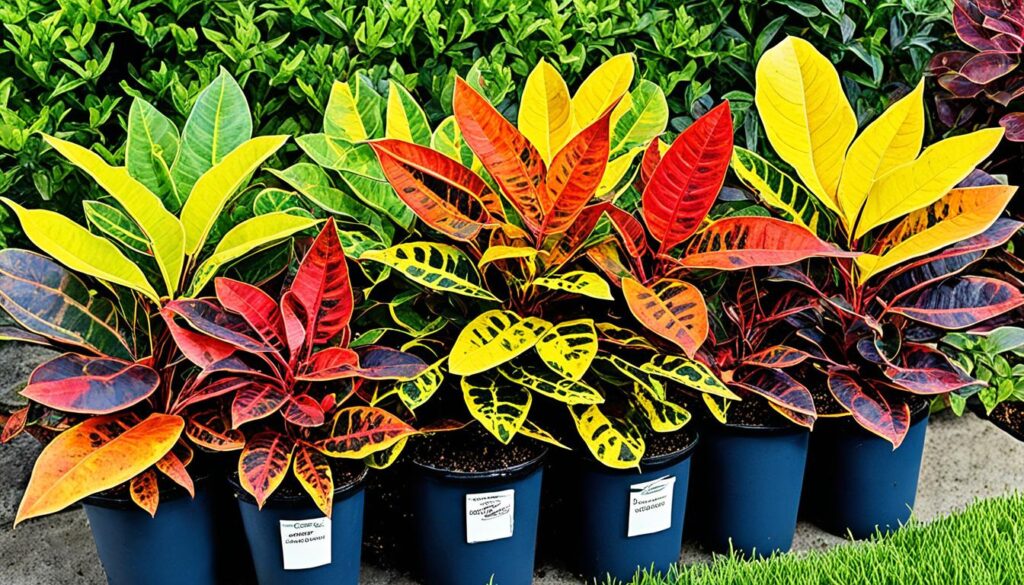
With the right care, your Croton plant will flourish. Pay attention to its needs, and it will become a lovely indoor plant.
Dealing with Pests and Diseases in the Croton Plant
Croton plants may face pests and diseases. Check your Croton regularly to keep it healthy.
Common Pests
Croton plants might get:
- Spider mites
- Mealybugs
- Aphids
These pests can harm the plant’s leaves and health if not treated.
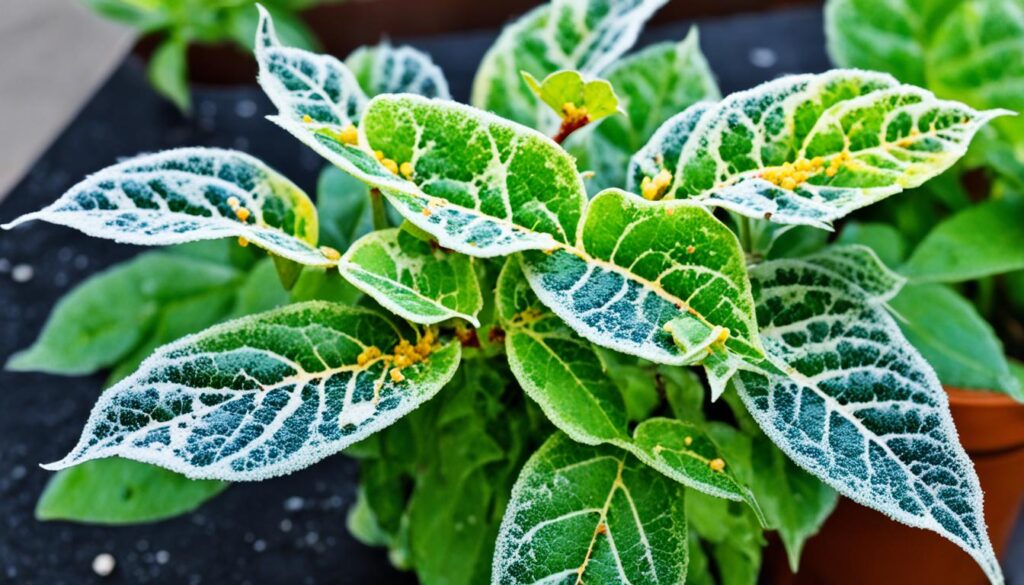
Pest Control
See webbing, sticky stuff, or weird leaves? Time to act.
- Using insecticidal soap
- Applying neem oil
These can kill pests safely.
Croton Plant Diseases
Croton plants might also get:
- Root rot
- Leaf spot
These issues can harm the plant. Take care of your plant to avoid them.
Prevention and Treatment
To stop pests and diseases, keep your Croton clean. Give it fresh air. Clean leaves often. Treat any disease signs quickly.
Preventing problems is key. Care, watch, and treat right away. This keeps your plant healthy.
Common Croton Plant Pests
Croton plants can draw pests that harm their look and health. Knowing these pests and controlling them helps keep Crotons healthy.
“A healthy Croton plant beautifies any indoor area. But, it’s crucial to know about pests. And to act to stop harm.”
Here are pests that often bother Croton plants:
- Spider Mites: Small pests that suck sap and cause leaf webbing and color loss. They like dry places and can harm plants if not stopped.
- Mealybugs: Tiny, white bugs that eat plant sap and slow growth. They leave a white fluff on plants, which is easy to see.
- Aphids: Small, soft bugs that also eat sap. They can twist leaves. If not checked, they quickly grow in number.
Check your Crotons often for pests, like bugs, webs, or sticky stuff. If you find bugs, control them to stop more harm. You can try these ways to get rid of pests:
- Manual Removal: Wipe off pests with a wet cloth or sponge.
- Insecticidal Soap: Spray the plant with a gentle, safe soap. Always follow the bottle’s directions.
- Neem Oil: Neem oil is a natural pest fighter. Mix as directed and cover the plant well.
Watch your plants closely and act fast to stop pests. This keeps your Crotons healthy.
Natural Predators
Using natural predators is a good way to control pests in a Croton plant. Ladybugs, lacewings, and predatory mites love to eat pests like spider mites and aphids. Adding these helpful bugs to your indoor garden keeps pests away.
Sometimes, pests spread a lot or an infestation gets really bad. When this happens, you need to separate sick plants from healthy ones. This stops pests from moving and hurting more plants.
If you must use chemicals to fight pests in Croton plants, pick ones made for indoors. They should be safe for people and pets. Always follow the instructions to use them right.
Using helpful bugs, keeping plants apart, or using chemicals can keep your Croton plants healthy. This saves them from pests that could hurt them.
Disease Prevention For Croton Plants
Keeping your Croton plant healthy means preventing diseases. This needs good care of the plant. Here are some important tips:
- Regular cleaning of leaves: Dust can gather on the leaves of Crotons. It’s important to clean them often. Use a damp cloth or a soft water spray to keep them dust-free.
- Proper watering practices: Too much water can cause fungus. Too little can stress the plant. Find a balance. Keep the soil moist but not too wet. Check the soil and change how much you water as needed.
- Adequate air circulation: Good airflow stops moisture buildup. This helps keep pests and diseases away. Don’t put your Croton in a crowded space. Giving plants enough room helps air move and keeps diseases away.
- Avoidance of overcrowding: Too many plants close together can spread diseases. Don’t pack them in. Each plant needs room to grow well.
- Promptly addressing signs of disease: Spotting diseases early is important. Check your Croton often for signs like leaf spots or wilting. If you see problems, act fast. You might need to remove sick parts, change how you take care of it, or use treatments.
Follow these steps and keep your plant clean. This will help your Croton stay healthy and strong.
Tips for Maintaining Croton Plants
Keeping your Croton plants happy takes regular work. Here are key tips for indoor Crotons:
Wiping Leaves
Clean leaves are a must for your plant. Use a moist cloth for this. Dust can slow down photosynthesis. Wipe each leaf gently to get rid of dust or dirt. Make sure you clean the top and bottom.
Outdoor Exposure
Your Croton can enjoy the outdoors when it’s warm. Move it outside for fresh air and sunlight. But, avoid direct sunlight and bad weather. Choose a spot with shade but still gets light.
Adjusting Watering Schedule
Watering your Croton right is crucial. Change how much you water with the seasons. Water more in spring and summer. But don’t water too much. This can harm the plant. Water less in fall and winter. Always check the soil before watering.
Regular care makes Croton plants flourish. They’ll make your space more colorful too.
Tips for Successful Overwintering of Croton Plant
Croton plants love warmth and humidity but winter is cold and dry. To keep your Croton happy in winter, here are some tips:
- Keep your Croton plant in a warm, humid spot inside. Make sure it’s away from cold drafts and windows.
- To add moisture, use a humidifier or place a water tray nearby. This helps create a humid area around your Croton.
- Check the room’s temperature where your Croton is. It should be between 60°F and 80°F for the plant to do well.
- In winter, water your Croton less often to avoid too much water in the soil. Wait until the soil is dry on top before watering again.
Follow these tips to care for and protect your Croton in winter. This will help it survive and grow during the colder months.
Growing Croton Plant from Seed
Growing Croton plants from seed is a fun challenge. It’s different from cutting stems or dividing the plant. You get to see the whole growth from the start. Here is how to do it:
1. Collecting Mature Seeds: First, get mature seeds from a healthy Croton. The seeds should be fully grown and dark.
2. Softening the Seeds: Soak the seeds in warm water for a day. This makes the hard seeds softer and easier to sprout.
3. Planting the Seeds: Mix potting soil, perlite, and sand for good soil. Put the soil in a container and plant the seeds just below the surface. Give each seed space to grow.
4. Providing Ideal Conditions: Keep the container in a warm, bright spot. Use indirect sunlight, not direct. The best temperature is between 70°F to 80°F.
5. Watering and Care: The soil should be moist, not wet. Water gently to not hurt the seeds or seedlings. A spray bottle works great to keep the right moisture.
6. Patience is Key: Waiting for Croton seeds to sprout takes time. It could be weeks or even months. Stay patient and make sure the soil stays moist.
7. Transplanting: When the seedlings are ready, move them to their pots. Use similar soil. Be careful with their roots.
8. Caring for Mature Croton Plants: Take care of them like grown Croton plants. They need bright light, water, and food. Watch out for bugs or sickness, and act fast if needed.
Growing Croton plants from seed is very rewarding. You get to see them grow from the start. With care and patience, you can raise your own Croton plants from seeds.
Varieties of Croton Plant
The Croton plant comes in many bright and beautiful kinds. Each type has its own special leaf colors and designs.
‘Petra’ is a favorite, with its bright red, orange, and yellow leaves. It really stands out. ‘Mammy’ has big, colorful leaves that bring a tropical look inside. For something more understated but still pretty, ‘Gold Dust’ is perfect. It has green leaves with gold spots.
‘Norma’, ‘Mrs. Iceton’, and ‘Magnificent’ are also great Croton types. Each one brings its own special beauty to your place. With so many to pick from, you can easily find a Croton that fits your style and adds beauty to your home.

